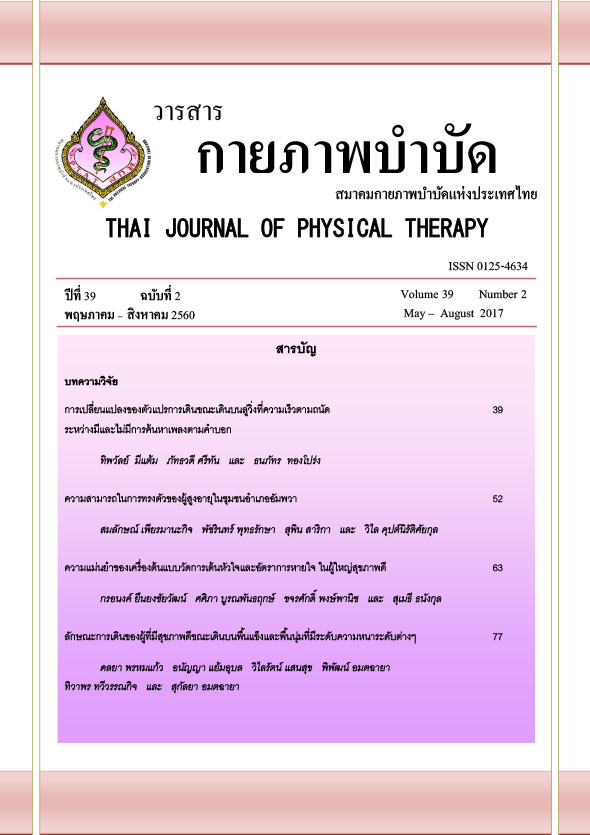ความสามารถในการทรงตัวของผู้สูงอายุในชุมชนอำเภออัมพวา
Main Article Content
บทคัดย่อ
ที่มาและความสำคัญ: การทรงตัวเป็นปัญหาสำคัญในผู้สูงอายุที่อาจนำไปสู่การหกล้ม กระดูกหัก และส่งผลต่อคุณภาพชีวิต
วัตถุประสงค์: ศึกษาระดับการทรงตัวในผู้สูงอายุรวมถึงปัจจัยที่เกี่ยวข้อง
วิธีการ: การศึกษาภาคตัดขวางนี้ทำในผู้สูงอายุในชุมชนอำเภออัมพวา จังหวัดสมุทรสงคราม ผู้สูงอายุทุกคนจะได้รับการบันทึกข้อมูลพื้นฐาน และประเมินความสามารถในการทรงตัวโดยการทดสอบด้วยการยืนเท้าชิด ยืนต่อส้น และยืนขาเดียว จับเวลาที่ทำได้ จัดกลุ่มของระดับความสามารถตามเกณฑ์ของ SIDE (The Standing test for Imbalance and Disequilibrium) ซึ่งแบ่งเป็น 6 ระดับ นำข้อมูลที่ได้มาวิเคราะห์หาความชุกของระดับการทรงตัวบกพร่อง โดยแยกตามเพศและอายุ รวมทั้งหาปัจจัยที่เกี่ยวข้องกับการทรงตัวบกพร่อง ได้แก่ อายุ เพศ ดัชนีมวลกาย ประวัติข้อเข่าเสื่อม ประวัติปวดหลังในปัจจุบัน ประวัติหกล้มในปีที่ผ่านมา และดัชนี OSTA (Osteoporosis Self Assessment Tool for Asian)
ผลการศึกษา: พบผู้สูงอายุที่มีระดับการทรงตัวบกพร่องตามเกณฑ์จำนวน 42 รายจากทั้งหมด 234 ราย คิดเป็นร้อยละ 18.0 (95% CI: 13.6 -23.4) เพศหญิงพบมากกว่าเพศชาย (ร้อยละ 19.5 และร้อยละ 13.3) และพบมากขึ้นตามอายุ (ร้อยละ 7.8 ในช่วงอายุ 60-69 ปี และร้อยละ 29.3 ในช่วงอายุ 70-79 ปี และร้อยละ 33.3 ในช่วงอายุมากกว่าหรือเท่ากับ 80 ปี) ส่วนปัจจัยที่เกี่ยวข้องพบเพียงปัจจัยด้านอายุที่มีความสัมพันธ์กับการทรงตัวที่บกพร่องอย่างมีนัยสำคัญทางสถิติ มีเพียงปัจจัยเรื่องอายุเท่านั้นที่มีส่วนเกี่ยวข้องกับการทรงตัวบกพร่อง โดยอายุในช่วง 70-79 ปี มีค่า adjusted odd ratio เท่ากับ 5.29 (95%CI: 2.23, 12.56) และอายุมากกว่า 80 ปี มีค่า adjusted odd ratio เท่ากับ 7.18 (95%CI: 1.99, 25.95)
สรุปการศึกษา: การทรงตัวบกพร่องเป็นปัญหาสำคัญในกลุ่มผู้สูงอายุในชุมชน โดยเฉพาะผู้สูงวัยที่มีอายุเพิ่มมากขึ้น และควรเป็นกลุ่มที่ได้รับการคัดกรองและให้คำแนะนำเกี่ยวกับการทรงตัว เพื่อป้องกันหรือลดความเสี่ยงต่อการหกล้มและการเกิดกระดูกหักในอนาคต
Article Details
เอกสารอ้างอิง
2. Bloch RM. Geriatric Rehabilitation. In: Braddom RL, ed. Physical Medicine & Rehabilitation, 3rd edition. Philadelphia: Saunders: Elsevier, 2007: 1415-1431.
3. Viswanathan A, Sudarsky L. Balance and gait problems in the elderly. Handb Clin Neurol. 2012;103:623-34.
4. Hsu WL, Chen CY, Tsauo JY, Yang RS. Balance control in elderly people with osteoporosis. J Formos Med Assoc. 2014;113(6):334-9.
5. Nashner LM, Shupert CL, Horak FB, Black FO. Organization of posture controls: an analysis of sensory and mechanical constraints. Prog Brain Res. 1989;80:411-8.
6. Horak FB. Postural orientation and equilibrium: what do we need to know about neural control of balance to prevent falls? Age Ageing. 2006;35(Suppl. 2):ii7-ii11.
7. Maki BE, Sibley KM, Jaglal SB, Bayley M, Brooks D, Fernie GR, et al. Reducing fall risk by improving balance control: development, evaluation and knowledge-translation of new approaches. J Safety Res. 2011;42(6):473-85.
8. Ambrose AF, Cruz L, Paul G. Falls and Fractures: A systematic approach to screening and prevention. Maturitas. 2015;82(1):85-93.
9. Quigley PA, Campbell RR, Bulat T, Olney RL, Buerhaus P, Needleman J. Incidence and Cost of Serious Fall-Related Injuries in Nursing Homes. Clin Nurs Res. 2011(1); 21:10-23.
10. Ambrose AF, Paul G, Hausdorff JM. Risk factors for falls among older adults: a review of the literature. Maturitas. 2013;75(1):51-61.
11. Grundstrom AC, Guse CE, Layde PM. Risk factors for falls and fall-related injuries in adults 85 years of age and older. Arch Gerontol Geriatr. 2012;54(3):421-8.
12. Hartikainen S, Lönnroos E, Louhivuori K. Medication as a risk factor for falls: critical systematic review. J Gerontol A Biol Sci Med Sci. 2007; 62(10): 1172-81.
13. Muir SW, Berg K, Chesworth BM, Klar N, Speechley M. Modifiable Risk Factors Identify People Who Transition from Non-fallers to Fallers in Community-Dwelling Older Adults: A Prospective Study. Physiother Can. 2010; 62(4): 358-67.
14. WHO Expert Consultation. Appropriate body-mass index for Asian populations and its implications for policy and intervention strategies. Lancet. 2004; 363(9403): 157-63.
15. Koh LK, Sedrine WB, Torralba TP, Kung A, Fujiwara S, Chan SP, et al. A simple tool to identify asian women at increased risk of osteoporosis. Osteoporos Int. 2001; 12(8): 699-705.
16. Teranishi T, Kondo I, Sonoda S, Wada Y, Miyasaka H, Tanino G, et al. Validity study of the standing test for imbalance and disequilibrium (SIDE): Is the amount of body sway in adopted postures consistent with item order? Gait Posture. 2011; 34(3): 295-9.
17. Coelho T, Fernandes Â, Santos R, Paúl C, Fernandes L. Quality of standing balance in community-dwelling elderly: Age-related differences in single and dual task conditions. Arch Gerontol Geriatr. 2016;67:34-9.
18. Cadore EL, Rodríguez-Mañas L, Sinclair A, Izquierdo M. Effects of different exercise interventions on risk of falls, gait ability, and balance in physically frail older adults: a systematic review. Rejuvenation Res. 2013;16(2):105-14.
19. Tofthagen C, Visovsky C, Berry DL. Strength and balance training for adults with peripheral neuropathy and high risk of fall: current evidence and implications for future research. Oncol Nurs Forum. 2012;39(5):E416-24.
20. Liu-Ambrose T, Khan KM, Eng JJ, Janssen PA, Lord SR, McKay HA. Resistance and agility training reduce fall risk in women aged 75 to 85 with low bone mass: a 6-month randomized, controlled trial. J Am Geriatr Soc. 2004; 52(5):657-65.
21. Kuptniratsaikul V, Praditsuwan R, Assantachai P, Ploypetch T, Udompunturak S, Pooliam J. Effectiveness of simple balancing training program in elderly patients with history of frequent falls. Clin Interv Aging. 2011;6:111-7.
22. Teyhen DS, Riebel MA, McArthur DR, Savini M, Jones MJ, Goffar SL, et al. Normative data and the influence of age and gender on power, balance, flexibility, and functional movement in healthy service members. Mil Med. 2014;179(4):413-20.
23. Soto-Varela A, Rossi-Izquierdo M, Faraldo-García A, Vaamonde-Sánchez-Andrade I, Gayoso-Diz P, Del-Río-Valeiras M, et al. Balance Disorders in the Elderly: Does Instability Increase Over Time? Ann Otol Rhinol Laryngol. 2016;125(7):550-8.
24. Slemenda C, Brandt KD, Heilman DK, Mazzuca S, Braunstein EM, Katz BP, et al. Quadriceps weakness and osteoarthritis of the knee. Ann Intern Med. 1997;127(2):97-104.
25. Simonsen EB. Contributions to the understanding of gait control. Dan Med J. 2014;61(4):B4823.
26. Carter ND, Khan KM, Mallinson A, Janssen PA, Heinonen A, Petit MA, et al. Knee extension strength is a significant determinant of static and dynamic balance as well as quality of life in older community-dwelling women with osteoporosis. Gerontology. 2002; 48(6): 360-8.
27. Segal NA, Glass NA. Is quadriceps muscle weakness a risk factor for incident or progressive knee osteoarthritis? Phys Sportsmed. 2011;39(4):44-50.
28. Assantachai P, Muangpaisan W, Intalapaporn S, Sitthichai K, Udompunturak S. Cut-off points of quadriceps strength, declines and relationships of sarcopenia-related variables among Thai community-dwelling older adults. Geriatr Gerontol Int. 2014;14 Suppl 1:61-8.
29. Chomiak T, Pereira FV, Hu B. The single-leg-stance test in Parkinson's disease. J Clin Med Res. 2015;7(3):182-5.
30. Jacobs JV, Horak FB, Tran VK, Nutt JG. Multiple balance tests improve the assessment of postural stability in subjects with Parkinson's disease. J Neurol Neurosurg Psychiatry. 2006;77(3):322-6.


